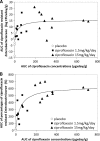Correlation between fecal concentrations of ciprofloxacin and fecal counts of resistant Enterobacteriaceae in piglets treated with ciprofloxacin: toward new means to control the spread of resistance?
- PMID: 22751547
- PMCID: PMC3421848
- DOI: 10.1128/AAC.06402-11
Correlation between fecal concentrations of ciprofloxacin and fecal counts of resistant Enterobacteriaceae in piglets treated with ciprofloxacin: toward new means to control the spread of resistance?
Abstract
We assessed in a piglet model the relationship between fecal ciprofloxacin concentrations and ciprofloxacin-resistant Enterobacteriaceae counts. Twenty-nine piglets were orally treated with placebo or with 1.5 or 15 mg ciprofloxacin/kg of body weight/day from day 1 (D1) to D5. Areas under the curve (AUC) of concentrations increased sharply with dose and correlated positively with AUC of resistant bacteria log counts between D1 and D9. Removing residual colonic quinolones could help to control the emergence of resistance in fecal flora.
Figures


Similar articles
-
Mathematical modeling of bacterial kinetics to predict the impact of antibiotic colonic exposure and treatment duration on the amount of resistant enterobacteria excreted.PLoS Comput Biol. 2014 Sep 11;10(9):e1003840. doi: 10.1371/journal.pcbi.1003840. eCollection 2014 Sep. PLoS Comput Biol. 2014. PMID: 25210849 Free PMC article.
-
Impact of residual and therapeutic doses of ciprofloxacin in the human-flora-associated mice model.Regul Toxicol Pharmacol. 2005 Jul;42(2):151-60. doi: 10.1016/j.yrtph.2005.03.001. Regul Toxicol Pharmacol. 2005. PMID: 15963836
-
Changes in concentrations of fluoroquinolones and of ciprofloxacin-resistant Enterobacteriaceae in chicken feces and manure stored in a heap.J Environ Qual. 2012 May-Jun;41(3):754-63. doi: 10.2134/jeq2011.0313. J Environ Qual. 2012. PMID: 22565257 Clinical Trial.
-
Ciprofloxacin dosage and emergence of resistance in human commensal bacteria.J Infect Dis. 2009 Aug 1;200(3):390-8. doi: 10.1086/600122. J Infect Dis. 2009. PMID: 19563257 Free PMC article. Clinical Trial.
-
Resistance in gram-negative bacteria: enterobacteriaceae.Am J Med. 2006 Jun;119(6 Suppl 1):S20-8; discussion S62-70. doi: 10.1016/j.amjmed.2006.03.013. Am J Med. 2006. PMID: 16735147 Review.
Cited by
-
Bystander Selection for Antimicrobial Resistance: Implications for Patient Health.Trends Microbiol. 2019 Oct;27(10):864-877. doi: 10.1016/j.tim.2019.06.004. Epub 2019 Jul 6. Trends Microbiol. 2019. PMID: 31288975 Free PMC article. Review.
-
PK-PD Integration Modeling and Cutoff Value of Florfenicol against Streptococcus suis in Pigs.Front Pharmacol. 2018 Jan 17;9:2. doi: 10.3389/fphar.2018.00002. eCollection 2018. Front Pharmacol. 2018. PMID: 29387013 Free PMC article.
-
Pharmacokinetics and pharmacodynamics integration of danofloxacin against Eschrichia coli in piglet ileum ultrafiltration probe model.Sci Rep. 2021 Jan 12;11(1):681. doi: 10.1038/s41598-020-80272-7. Sci Rep. 2021. PMID: 33436914 Free PMC article.
-
Optimization of Antimicrobial Treatment to Minimize Resistance Selection.Microbiol Spectr. 2018 May;6(3):10.1128/microbiolspec.arba-0018-2017. doi: 10.1128/microbiolspec.ARBA-0018-2017. Microbiol Spectr. 2018. PMID: 29932044 Free PMC article. Review.
-
Aggressive or moderate drug therapy for infectious diseases? Trade-offs between different treatment goals at the individual and population levels.PLoS Comput Biol. 2019 Aug 12;15(8):e1007223. doi: 10.1371/journal.pcbi.1007223. eCollection 2019 Aug. PLoS Comput Biol. 2019. PMID: 31404059 Free PMC article.
References
-
- Donskey C. 2004. The role of the intestinal tract as a reservoir and source for transmission of nosocomial pathogens. Clin. Infect. Dis. 39:219–226 - PubMed
-
- Khoder L, Tsapis N, Domergue-Dupont V, Gueutin C, Fattal E. 2010. Removal of residual colonic ciprofloxacin in the rat by activated charcoal entrapped within zinc-pectinate beads. Eur. J. Pharm. Sci. 41:281–288 - PubMed
-
- Kitsis MD. 2009. Measurement of antibiotics in human body fluids. In Courvalin P, Leclercq R, Rice L. (ed), Antibiogram. ESKA and ASM Press, Washington, DC
Publication types
MeSH terms
Substances
LinkOut - more resources
Full Text Sources
Medical

